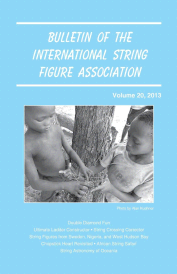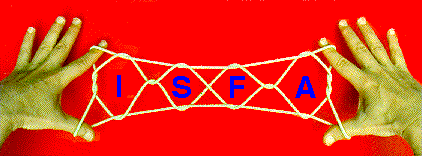volume 20 (2013) - Table des Matières
Edité par - Mark A. Sherman, Pasadena, California
Rédacteurs Associés - Joseph D'Antoni, Queens, New York; Myriam Namolaru, Haifa, Israel;
Belinda Holbrook, Davenport, Iowa; Stephan Claassen, Best, Netherlands.
Comité de Rédaction - Hiroshi Noguchi, Tokyo, Japan; Philip Noble, Inverness, Ecosse
Le Bulletin de l'Association Internationale du Jeu de Ficelle (BISFA) est une publication savante
présentant des documents originaux qui fait progresser notre compréhension et renforce
notre plaisir des jeux de ficelle. BISFA est publié annuellement, en septembre, par ISFA Press
(Pasadena, Californie). BISFA remplace le Bulletin de l'Association des Jeux de Ficelle,
(Toky Nippon Ayatori Kyokai), qui a été publiée en 19 volumes (1978-1993).
Les traductions proposées ne comprennent pas les illustrations et photos du texte original.
J'ai traduit ces textes pour vous donner un aperçu de la qualité et de la richesse de
ces publications.
Table of Contents - Volume 20 (2013): 256 pages

Research Reports
- Double Diamonds, Mirror Images, Optical Illusions, Coloured Loops, Red Setters, and a Moral Ending by Martin Probert, Devonshire, UK (pages 1-8) - There are many different forms of the Double Diamond, forms which share the same silhouette but differ in one or more crossings. We ask why anyone would wish to know all these possible Double Diamond forms, and give two answers. We illustrate six forms from which, by rotations and/or reflections, all the other forms can be obtained. A method is given for the previously unknown form. We join Alice in Through the Looking-Glass to gain an insight into left-handed and right-handed figures. A minor optical illusion of the Double Diamond is explained. We conjure up and experiment with a two-colour loop, and use it to form Overlapping Diamonds. Techniques are introduced for dealing with string figure instructions involving a series of loop-through-loop transfers, and these techniques are used to rework the previously unknown form of the Double Diamond. We finish with a transformation of the Double Diamond.
- The Ultimate Ladder Constructor: An infinity of ladders from a few memorised instructions by Martin Probert, Devonshire, UK (pages 9-17) - Complex ladders — elaborations of the Jacob’s Ladder type — have previously required a complex analytical approach for their construction. In this article a single versatile and easily-memorable construction for such ladders is presented. Once the moves are learnt, the maker is able to fashion a multitude of different ladders without any reference to instructions. Multiple-sided frames, and multiple-sided diamonds, are possible for all ladders. Hexagons and rectangles can appear among the diamonds. One happy consequence is the ease of constructing a series of attractive ladders for display purposes.
- The Testing and Correcting of String Figure Diagrams by Martin Probert, Devonshire, UK (pages 18-38) - There have been several articles in this Bulletin (Shishido 1996, D’Antoni 2002, Laile et al. 2006, D’Antoni 2011) which explain how to test whether a diagram is really a string figure. The method is to take a length of string, thread it into the diagrammed shape, tie the two ends together, and then try to unwrap it completely. If the unwrap results in a simple loop, the diagram represents a string figure. The disadvantage of this method is that it cannot pinpoint which crossings might need to be changed. This article is devoted to explaining a technique evolved specifically to reveal which crossings of a ‘string-figure knot’ need changing to obtain a genuine string figure. The technique is easy to use. It is the perfect tool for correcting the crossings of string figures designed on paper, and may prove useful for establishing a working figure from faulty reproductions of traditional figures for which no known method exists, and which do not seem to be constructed by traditional techniques. It may be that, with the aid of this technique, string figure enthusiasts with artistic talent will be able to devise string figures that would not be easy to produce by other means. Note: Since the above article was written, a program has been completed to carry out the work of testing string figure diagrams. The program can be found here.
- Some Nigerian String Figures by Philip D. Noble, Inverness, Scotland (pages 39-63) - Fifteen previously unknown photographs of Nigerian string figures taken by N.W. Thomas, between 1909 and 1911 and held in the Royal Anthropological Institute archives in London are analysed and reconstructed methods are suggested for all of the designs, using techniques described in previous collections from nearby geographical regions.
- Chopstick Heart Revisited by James R. Murphy (inoli), New York, New York (pages 64-91) - ‘Chopstick Heart’ is the name of an invented string figure presented in my previously published article on Opening Theory (Murphy 2001). Since then i have continued to explore an aspect of string figure instability referred to as “intensionality” and in the process have created several dozen new variations. Some of these feature a “heart within a heart”, while others, which begin with so-called “slant openings” feature a square knot in the center. i end this article with instructions for making an amusing design that resembles the face of a famous cartoon mouse.
- Making String Figures and Friends in Africa by Alan Kuehner, Olive Hill, Kentucky (pages 92-125) - The author describes fourteen string figures and two instances of cat’s cradle playing, mainly recorded during a 2012 trip through seven countries in Africa.
- Swedish String Figures IV: String figures used in folk medicine by Stephan Claassen, Best, the Netherlands (pages 126-152) - The author describes two instances of the use of string figures in traditional Swedish folk medicine. A krampknut (“cramp-knot”), made out of a string loop, was applied to cure cramped limbs of humans or small animals. A construction method for this krampknut has survived, but curiously this does not exactly match the preserved specimens of the knot. Another string figure is used in a ritual performed by a specialist healer from Fru Alstad, southern Sweden.
- Some String Figures of the Qairnirmiut Inuit, as recorded by Jean Michéa by Stephan Claassen, Best, Netherlands, and Joseph D'Antoni, Queens, New York (pages 153-187) - The authors propose construction methods for 18 string figures and tricks which are supposed to be of the Quairnirmiut Inuit. The construction methods are based upon 120 photographs showing Swiss/French ethnologist Jean Michéa making the figures. The photographs are stored in the archives of the Canadian Museum of History. One figure has probably not been recorded before. Of one figure, representing a shaman, only drawings of its construction have been published before, although the figure is also found in two manuscripts.
- Some String Figures and Tricks from Rankin Inlet by Kathy Elbaum (1944-2007), and Mark Sherman, Pasadena, California (pages 188-224) - In this article methods for making twenty-two Inuit string figures and six string tricks are presented. The figures and tricks were gathered at Rankin Inlet (Kangiqliniq, Nunavut, Canada) in July and August of 1971. The author’s informants included Caribou, Netsilik, and Iglulik Inuits. Of the twenty-two figures, two have not been reported previously in the published literature. Of the six tricks one appears to have Nordic roots, perhaps reflecting contact with European whalers which became frequent in the 19th century. Additional details about the legendary “spirit of string figures” are provided, as well as a newly recorded song which accompanies a figure representing bears. Performance aspects (speed and fluidity) are also discussed.
- String Astronomy of Oceania by Alexey Andreev, Moscow, Russia (pages 225-231) - In this brief report the author broadens our appreciation of Oceanic string figures that represent stars, planets, and constellations by showing how their designs illustrate various aspects of ancient Oceanic astronomy.
Book Reviews - by Joseph D'Antoni (pages 232-235)
- String figure books from China, An illustrated listing of 13 books.
Nomenclature - by Mark Sherman (pages 236-251)
- Abbreviations and terms used throughout the Bulletin are summarized and illustrated. Step-by-step illustrations for making five string figures (Look!, Drum, Two Fawns, Face Mask, and Two Arrowheads) are provided as examples.
Ajouter un commentaire





